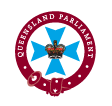-
Visit and learn
- Message from the Speaker
-
About Us
- A day in the Life of the Queensland Parliament
- The Executive Government of Queensland
- Officers of the Queensland Parliament
- The Origins of the Queensland Parliament
- The Queensland Parliament and Parliamentary Process
- Parliamentary Scrutiny via Parliamentary Committees
- The Queensland Parliament and the Financial Process
- The Queensland Parliament and the Legislative Process
- The Queensland Constitution
- The Queensland Electoral System
- The Role of Parliament
- Separation of Powers
- Learn About Parliament
- Information For
- Visitors
- Visit the Public Gallery
- Visit our Gift Shop
- Have Your Say
- Get Involved
- Education and Learning
- History
- Heritage Collections
- Preservation of our Heritage
- Regional Sittings
- CPA Australia and Pacific Regional Conference
- Publications and Reports
- Speakers' Corner
- Opening of the 58th Parliament
- Parliamentary Annexe Reparation and Refurbishment
- Contact Us
The Queensland Parliament consists of the Monarch and the Legislative Assembly. In accordance with the State’s constitution, the Monarch is personally represented by the Governor.
The Queensland Parliament is unicameral, meaning it has only one parliamentary chamber, the Legislative Assembly. The upper chamber, the Legislative Council, was abolished in 1922.
There are currently 93 members of the Legislative Assembly who each serve for a fixed four-year term.
Parliament House is located at the corner of George and Alice Streets in the Brisbane central business district and is surrounded by the City Botanic Gardens, the Queensland University of Technology Gardens Point campus and the Brisbane River.
A day in the Life of the Queensland Parliament
The following provides an outline of the routine of business during a sitting day in the Queensland Parliament. Several procedures that happen on different days have been included in order to demonstrate the various types occurring during a parliamentary week.
Read moreThe Executive Government of Queensland
Queensland's system of Government is a constitutional monarchy and, in its broadest sense, consists of the Governor and Executive Council, and the Legislative Assembly, with the judiciary completing the constitutional trinity.
Read moreOfficers of the Queensland Parliament
The Queensland Parliament is presided over by a number of officers who are responsible for the proceedings of the Legislative Assembly's business and the daily administration of the parliamentary complex.
Read moreThe Origins of the Queensland Parliament
The Queensland Parliament can trace its origins back to the British parliamentary or Westminster system. Because Britain was the colonising nation and the majority of Queensland’s early settlers were of British ancestry, it was a natural consequence that the colony’s legislature would be based on the British model.
Read moreThe Queensland Parliament and Parliamentary Process
(Including the parliamentary calendar, the parliamentary chamber, the opening of Parliament, the election of the Speaker, the Governor’s opening Speech and the Address-in-Reply debate) Meetings of Parliament involve complex and time-honoured processes based on tradition, the Standing and Sessional Orders, as well as the volatile, unpredictable ingredients resulting from adversarial, party politics.
Read moreParliamentary Scrutiny via Parliamentary Committees
Although Executive Governments originate from the Parliament, because of the advent of 20th century political parties they have tended to develop wills of their own. Over the years, therefore, the Parliament has evolved particular procedures and structures which are aimed at scrutinising an Executive Government's policies and performance.
Read moreThe Queensland Parliament and the Financial Process
The scrutiny by Parliament of the Government's annual financial requirements is an important and powerful feature of the legislature's role, and personifies the House of Commons' long, arduous battle that eventually saw it gain control over the British monarchs' revenues and expenditures.
Read moreThe Queensland Parliament and the Legislative Process
One of the principal and familiar roles of the Queensland Parliament involves the passing of legislation which establishes the laws of the State. A piece of legislation passed by the Parliament becomes an Act or Statute, and in its draft form prior to and during its legislative passage is called a Bill.
Read moreThe Queensland Constitution
Until recently, Queensland’s Constitution was located within a diverse range of legislative instruments, i.e. statutes (Imperial, Federal, State), Letters Patent, proclamations and an Order in Council. However, as a result of the work of a number of bodies, the Queensland Constitution has been consolidated into the Constitution of Queensland 2001 which came into effect on Queensland Day (6 June) 2002.
Read moreThe Queensland Electoral System
Queensland’s present electoral system is governed by the Electoral Act 1992, which creates an independent authority, the Electoral Commission of Queensland, to — conduct State elections, by-elections and referendums; administer Queensland’s electoral laws; maintain the electoral roll; conduct redistributions of electoral district boundaries; undertake research; and educate Queenslanders about their democratic rights and obligations.
Read moreThe Role of Parliament
The Queensland Parliament is often viewed as an historic, sandstone structure which is located at the end of George Street, Brisbane, and is somehow connected to the State's laws.
Read moreSeparation of Powers
In its purest sense the doctrine separation of powers refers to the distinct separation of the three branches of Government - the legislature, the Executive and the judiciary.
Read moreInformation on Parliament
The Mace is the symbol of the Parliament’s authority via the Speaker, which has been derived from the Crown.
Read moreInformation For
Helpful information for Teachers, Students, Lawyers, Media, Members and support staff, First time visitors and government agencies
Read more